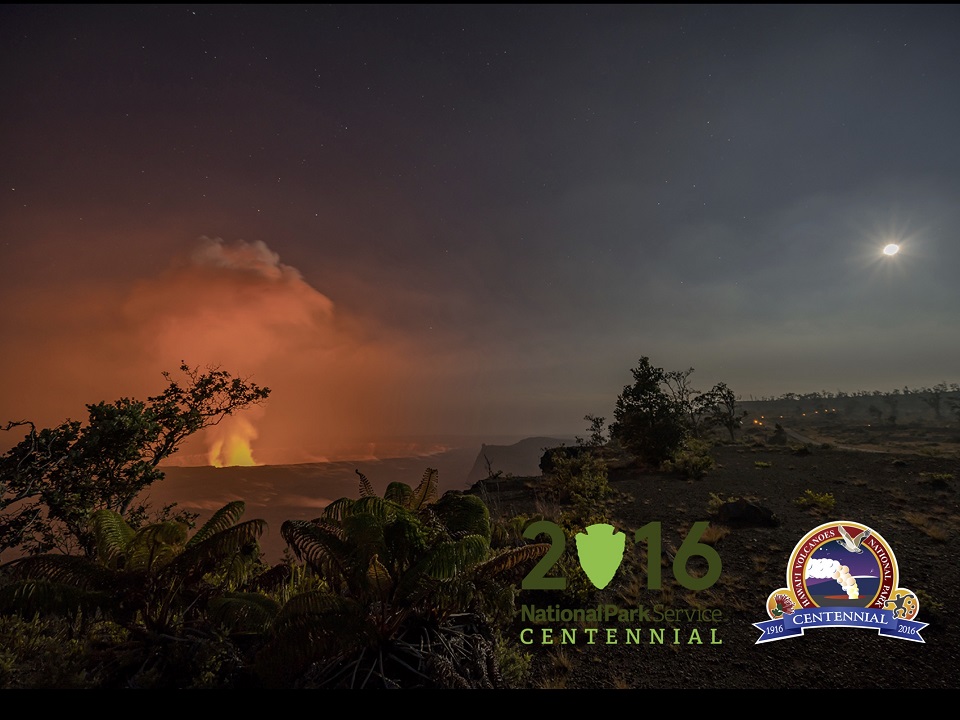|
You are viewing ARCHIVED content published online before January 20, 2025.
Please note that this content is NOT UPDATED, and links may not work. For current information,
visit https://www.nps.gov/aboutus/news/index.htm.

Eric Frandrick
Contact: Jessica Ferracane, 808-985-6018 Kīlauea is putting on quite a show for park visitors eager to see a volcanic eruption – just like it was 100 years ago today when Hawai‘i Volcanoes National Park was established on August 1, 1916.Today, as the park enters its next century, park visitors were treated to free entry, a native plant giveaway, Hawaiian music by Ken Makuakāne, lei making and kōnane (Hawaiian checkers), plus presentations about park efforts to save endangered nēnē (Hawaiian goose) and honu‘ea (Hawaiian hawksbill turtle). Lava cookies and centennial stickers were shared with the first 100 visitors who arrived for the festivities. A lava lake within Halema‘uma‘u Crater at the volcano’s 4,000-foot summit continues to rise and spatter, deflate and degas. At night, the lake casts a magnificent glow; by day, a plume of steam, particles and gas billows upward. Visitors can easily and safely observe this eruptive activity from an accessible overlook at Jaggar Museum.
“It is amazing that in 1916, the year the park was established, we had two eruptions. Mauna Loa erupted during May, and sent lava towards Kahuku, and Halema‘uma‘u fountained and spattered,” said Park Superintendent Cindy Orlando. “Fast forward 100 years and Kīlauea erupts from two locations. What an auspicious way to commemorate our centennial anniversary,” she said.
A week ago, out in the volcano’s remote east rift zone, lava from the Pu‘u ‘Ō‘ō vent streamed down forested cliffs and crossed an emergency access route. Early the next morning, streams of rough ‘a‘ā and smooth, viscous pāhoehoe lava plunged down jagged coastal cliffs into the ocean. This cascade of molten lava, at the Kamokuna ocean entry, has enlarged to almost 800 feet (240 m) across and is being fed by the active flow field on the coastal plain.
Park visitors are urged to stay away from the steep, unstable sea cliffs, and rangers have placed rope barriers along the ocean entry to keep people safe.
Hikers can access the active flow field from the end of Chain of Craters Road in the park, along the gravel emergency route (Chain of Craters-Kalapana Road), and are rewarded with beautiful sights of molten, flowing lava. It’s a long and hot hike, nearly five miles one-way. Preparation is key. Bring at least three to four quarts of water per person. Wear sturdy closed-toe hiking shoes or boots, gloves to protect the hands, and long pants to protect against lava rock abrasions. Wear sunblock, sunglasses and a hat. Visitors who plan to stay after dark need a flashlight and/or headlamp with extra batteries.
“There’s no way to tell what Kīlauea will do next, and it’s likely that someone will be saying the same thing 100 years from now,” Orlando said.
-NPS-

NPS Photo/Sami Steinkamp 
NPS Photo |
Last updated: August 1, 2016
